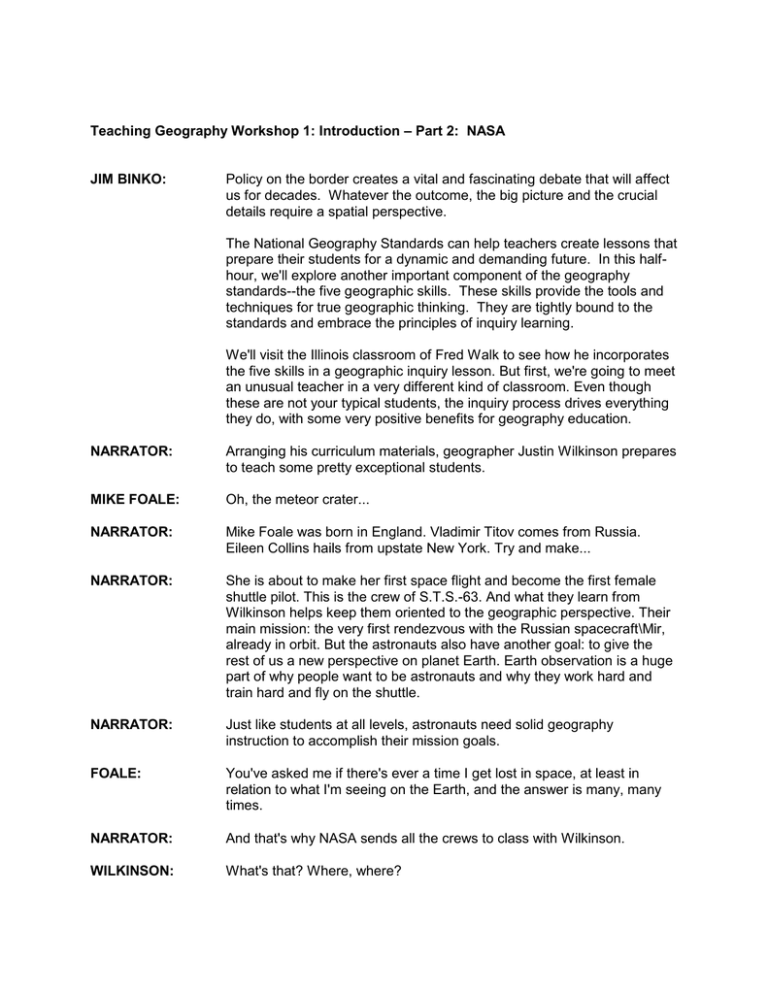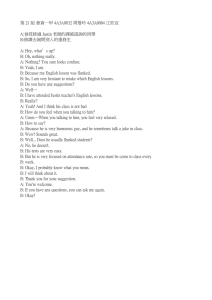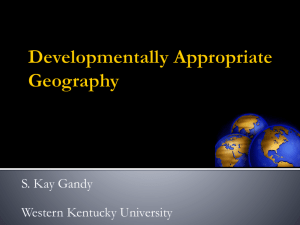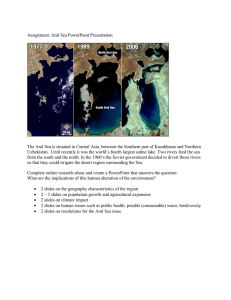Policy on the border creates a vital and fascinating debate... us for decades. Whatever the outcome, the big picture... – Part 2: NASA
advertisement

Teaching Geography Workshop 1: Introduction – Part 2: NASA JIM BINKO: Policy on the border creates a vital and fascinating debate that will affect us for decades. Whatever the outcome, the big picture and the crucial details require a spatial perspective. The National Geography Standards can help teachers create lessons that prepare their students for a dynamic and demanding future. In this halfhour, we'll explore another important component of the geography standards--the five geographic skills. These skills provide the tools and techniques for true geographic thinking. They are tightly bound to the standards and embrace the principles of inquiry learning. We'll visit the Illinois classroom of Fred Walk to see how he incorporates the five skills in a geographic inquiry lesson. But first, we're going to meet an unusual teacher in a very different kind of classroom. Even though these are not your typical students, the inquiry process drives everything they do, with some very positive benefits for geography education. NARRATOR: Arranging his curriculum materials, geographer Justin Wilkinson prepares to teach some pretty exceptional students. MIKE FOALE: Oh, the meteor crater... NARRATOR: Mike Foale was born in England. Vladimir Titov comes from Russia. Eileen Collins hails from upstate New York. Try and make... NARRATOR: She is about to make her first space flight and become the first female shuttle pilot. This is the crew of S.T.S.-63. And what they learn from Wilkinson helps keep them oriented to the geographic perspective. Their main mission: the very first rendezvous with the Russian spacecraft\Mir, already in orbit. But the astronauts also have another goal: to give the rest of us a new perspective on planet Earth. Earth observation is a huge part of why people want to be astronauts and why they work hard and train hard and fly on the shuttle. NARRATOR: Just like students at all levels, astronauts need solid geography instruction to accomplish their mission goals. FOALE: You've asked me if there's ever a time I get lost in space, at least in relation to what I'm seeing on the Earth, and the answer is many, many times. NARRATOR: And that's why NASA sends all the crews to class with Wilkinson. WILKINSON: What's that? Where, where? COLLINS: Dirt and water. MAN: And clouds. Is that the Hammerhead? Is that what? Is that the Hammerhead? No, this is all Africa. FOALE: It's not Johannesburg, is it? It's Morocco. That's Morocco! WILKINSON: Our job is to give the astronauts as strong a sense as we can of where they are on the Earth's surface before they fly. When an astronaut looks out of the window, latitude-longitude is almost meaningless. What they need to be able to do is to recognize Lake Chad or the Nile River Delta, or the peninsula of Florida or Cuba. These are all strongly recognizable places, and we build them into our training because they are recognizable major features. Okay, so now you know where the area is that's interesting. Let me just show you, to remind your... NARRATOR: Like all teachers, Wilkinson wonders how his students will perform after they graduate. That time has come. (\cheering\) ANNOUNCER: James Wetherbee. Commander James Wetherbee, pilot Eileen Collins. Mission specialist Michael Foale, mission specialist Janice Voss. Dr. Bernard Harris. ANNOUNCER 2: Three, two, one, and lift-off of Space Shuttle-Discovery on a mission to prepare for the next era of world cooperation in space. NARRATOR: Once in orbit, pilot Collins views the launch and retrieval of an orbiting camera. And Mike Foale takes a five-hour space walk to test a new suit. COLLINS: We were also the first crew to rendezvous with the space station Mir. We didn't dock, but we rendezvoused, and we were the first Americans to see Mir. MAN: 1,023, Houston. NARRATOR: Aboard the Mir, the cosmonauts aim their camcorder at the approaching shuttle, suddenly recognizing their countryman, Titov. (\men laughing, \exclaiming in Russian\) COLLINS: Ah, spasibo. (\men speaking Russian\) NARRATOR: Their main missions accomplished, the fast pace continues as they begin Earth photography. (\shutters clicking\) FOALE: We go into this big photo frenzy whenever we see land, and the legs and arms kicking around, cameras are clicking on the flight deck in all the windows when we're over land. But the world is two-thirds water. And what would happen is that as soon as we went over, say, from Kamchatka to the Pacific, everyone's saying, "Oh, it's the Pacific," and they'd all go downstairs and eat. And I would stay on the flight deck and just hang in the window. And you see almost nothing, but you won't believe how many little tiny islands there are. My favorite pastime was just imagining myself beamed down, as in Star Trek, right that minute, and go and lie on that beach for ten minutes and then beam right back up and go on to the next one. NARRATOR: Beaming up and down would teach him a lot of geography. By changing scale, he could see that this beach in Bali is a good place to surf. But if he lands on this beach, near the Kilauea Volcano in Hawaii, he might be killed by molten lava or the toxic steam it produces when it hits the seawater. So how would he know where it is safe to land? How do we know where we can visit or build a new home or factory? As educators, one of our goals is to help our students understand their world as it is and imagine it as it could be. Geographic inquiry, built upon the five geographic skills, can help us achieve this goal. As outlined in Geography for Life, the five geographic skills are: asking geographic questions, acquiring geographic information, organizing geographic information, analyzing geographic information, and answering geographic questions. It is no accident that these skills may remind us of the inquiry process. In fact, taken together, the five geographic skills outlined in Geography for Life define a clear process of geographic inquiry. This inquiry process is a powerful tool to develop geographic thinking in students. The skills inform how our teachers teach, how our students learn, and how geographers and other experts search for knowledge in the field. We now return to our astronauts and their search for knowledge. Their view from space provides a fresh perspective on the forces that shape our planet. NARRATOR: Satellites circle the Earth and send back many individual pictures. When such images are arranged in a mosaic and wrapped around a sphere, they give us a photographic view of Earth. It makes a new kind of globe that helps us map physical systems like the boundaries of tectonic plates. Human settlement patterns, too, depend on Earth's physical systems. When viewed from space, the limitations are glaring. FOALE: The vast area of the world can be described as one color, brown. Mostly a brown desert. And that is the absolutely most striking thing about it. You suddenly realize the places to live in the world are few and far between and we are already living there. We have found them, and that's where we've made our homes. So our living resources are actually quite limited in terms of space. NARRATOR: Take the case of Egypt. It's larger than Texas plus Oklahoma, but 95% of its 65 million people live in the narrow ribbon of the Nile River Valley and its delta. Astronauts saw this pattern graphically illuminated as they flew over at night. Night views from space can tell us a lot, but not just about population density. They often reveal levels of economic development. FOALE: I remember going over Tokyo, and you could see the whole Japanese island as if it had been drawn out on a map because they have put streetlights along every inch of their coastline all the way around, and so it just shines out like a perfect atlas illustration. NARRATOR: As the second largest economy in the world, Japan shows up very brightly. But compare it with developing countries on the Asian mainland. Together, China and India hold 38% of the world's population, but few places there shine like Japan. Similar contrasts appear to the west. The population of Africa exceeds radiant Europe, but suffers from underdevelopment. With under five percent of the world's population, the U.S. consumes 25% of world energy. Its nighttime image is blazing. What will happen if U.S. or Japanese rates of consumption are adopted by China and India as their economies continue to grow? A glimpse of the future may now be visible from space, a little to the north. The black cover on snow in Siberia astonished astronaut Mike Foale. FOALE: The cities in Russia are coal-burning cities, and so the soot from the coal burning has spread out over the snow surrounding the city, and you see this big, black smudge. It's almost like someone had rubbed their finger across a photograph, but looking at it out the window. NARRATOR: Cosmonaut Vladimir Titov talks about a town he knows in Siberia called Pavlodar. (\speaking Russian\) TRANSLATOR: If you look from the air, it's one of the dirtiest towns ever. Smoke is visible for hundreds of kilometers. I myself am from Siberia, and I know that many people in Siberia are very worried about pollution. NARRATOR: Around the world, growing populations place heavy new pressure on supplies of fresh water. Some of these are so severe, they can be seen from space. And we would look at the Aral Sea, and the Aral Sea, as you probably know, is a man-made disaster in terms of the dehydration of that region. There have been many water levels, and the water levels have been dropping consistently every year because of the diversion of water in the river that used to feed it. And so the Aral Sea has become very, very dry. There's very little water left in it. NARRATOR: Images like these can help change the way we learn about the world. Stark environmental problems are shown in their daunting global scale. But at the same time, the vision of one precious planet shared by all humanity can be a motivating source of hope and inspiration. BINKO: As we've seen, the view from space provides a powerful geographic perspective, revealing many things only visible from afar. The vivid images and maps developed through NASA missions are a rich source of teaching materials. One of the latest is a new series of geographic investigations called Mission Geography. Developed by NASA and GENIP, the Geography Education National Implementation Project, Mission Geography combines the power of these images with rigorous inquiry lessons that utilize the five geographic skills. One particularly striking example is the case of Russia's Aral Sea. In his lesson, Illinois teacher Fred Walk leads his high school class through a Mission Geography inquiry module as they answer the question, "Why is the Aral Sea shrinking?" We join them on their second day of the lesson as they continue the process of acquiring geographic information. FRED WALK: What you were doing was... was using that geographic information, weren’t you? I mean, you're... you’re acquiring the information by measuring the size of the Aral Sea. I’m going to give you another aerial satellite image and have you go through the same process and measure the size of the Aral Sea. I think the data I have... the image you’re going to see is from 1997. Okay? And then, once we determine the size of the Aral Sea--what it was in 1997--then what we’re going to do is focus on the big question; that is, why is the Aral Sea shrinking? So how are we going to figure it out? What do we need? We need some additional data, right? Or we need another satellite image, okay? We’re going to go through the same process-count the number of dots that touch the water’s surface, right? And then you’re going to calculate how many square miles. And then ultimately, what I want you to do is to answer on your log here numbers four and five. So you guys are... are sorting your way through this. I want you to reach consensus. So would you collaborate, just with the people around you, just... just communicate with... with one another? But you... you’re judging by your line, but it’s right on... it’s right on the line. I didn't count it and I still got 17. Maybe I did count that. WALK: Go ahead and...and show the change from yesterday. Do you guys understand how to calculate the change? How do you get the percentage? Ah, that’s a good question. "How do you get the percentage?" Let me give you a little more direction. WALK: You all agree you had 17 dots? BOY: I got 16. WALK: I had 17. Okay, why don’t you just, amongst yourselves...it’s an estimate, okay, so it’s not that big of a deal. But go ahead and calculate the percentage change. (\students discussing\) STUDENT: I'm just going to put 40. WALK: 40? That's something. WALK: How are we doing? How's it going? Have we... have we sorted it out? STUDENTS: Yeah. WALK: Really? BOY: Yep. WALK: All right, let’s take a look. Come up here, Ben, come on, come on, come on. Come on, come on. There you go, and show us what you’ve done here. You have... show us the black is...That's what year? BEN: The black is '64 and the red is '97 or whatever. WALK: Okay. You can see serious shrinkage, right? STUDENTS: Yeah. WALK: Yeah, okay. Did you calculate the percentage? STUDENT: Yeah. STUDENT 2: 41%. WALK: I got 42. I hear 40%, 41. What'd you say? 45. 58, 58. Yeah? I have some figures here from... straight from NASA themselves. The percentage change, they’re saying, is about 50%. But, with your estimates, it’s going to be between 40 and 60, so, you’re in the ball park. So, in 33 years, the Aral Sea has shrunk by 50%. BOY: So what happens in the next 30 years? It'll be gone? WALK: Oh, ask that question again, David. What’s going to happen in the next 30 years, it'll be gone? Yeah, Dan, did you hear that? No. He says, "What’s going to happen in the next 30 years? Will it be gone?" Or will it shrink by another 50%? See, that’s a good question, and that’s a question that all kinds of people are asking. Scientists are wondering that. People who live in Uzbekistan and Kazakhstan are wondering that--I mean, really. So what’s going to determine if the sea will continue to shrink? How do we... how could we answer that? The way it’s going, it... it won’t be there, but, like, the weather could change. Oh, the weather could change. So, see, what you’re starting to do right now is you’re trying to figure out why it has shrunk. And if we knew why it shrunk in the first place, could we better able answer that question that David posed: "What’s going to happen in the next 30 years?" BOY: Yeah. WALK: Yeah, I think so. Okay, so that's...that’s what we’re going to try and sort out. Why is the Aral Sea shrinking, okay? So we’re looking... notice it says "physical processes" and "human processes." All right? You guys understand the difference between a human process and a physical process? BOY: Yeah. WALK: Nate, what do you...what... what’s the distinction in your mind? NATE: Human process--say, if they were using the water for irrigation, but of course they can’t because it’s salt water, they’d be drawing the water away from there. WALK: Something... you mentioned like irrigation--that’s a good example of a human process. All right? Okay. What’s an example of a physical process? What’s that? BOY: A lack of rain. WALK: A lack of rain, lack of precipitation. All right, that’s a physical process, right? Okay. So what I want you to do is to... is to hypothesize about human processes, physical processes that have... that you think might have contributed to the shrinking Aral Sea. Yeah, Sonia. SONIA: Do you have any other, like, photographs of before, like, earlier than 1964 to see if it’s a pattern or if it’s just, like, this one time period? WALK: You’re thinking that this might be an aberration, that maybe it shrunk before and it’s gotten larger and shrunk before? SONIA: Well, I don’t know, it’d just help to understand, like, why it was, because if it had to do with humans then it might be shrinking more now than it was, like, a long time ago. WALK: Ah, that’s a good question. And I... I really encourage students to question, to question the information that they’ve been exposed to. It tends to promote more inquiry on... of them. You guys are asking some good questions. I like that. Take your atlas. There’s going to be some clues here. Look on page 169. I want you to locate the Aral Sea. Do you see the source of the Aral Sea? There’s two, aren’t there? Two what? Two... STUDENT: Two rivers. WALK: So, this river here, Syr-Darya--this is a river that flows out of the mountains here. And there’s another river. Where’s the other river? And that's the Amudar'ya. So, two major rivers. Clue-- there’s a clue. Physical processes, human processes, okay? Now turn to page 177. Now, Nate, you said earlier...there wouldn't be irrigation, huh? (\Nate answers softly\) Now, along these rivers here, what are you seeing? STUDENT: Specialized agriculture. WALK: Oh! What are you seeing? Specialized agriculture. "Specialized..." What else does it say? "Specialized agriculture" and what? STUDENT: "Oasis." WALK: "Oasis" what? Farming? What’s that? STUDENT: They’re doing it from the river, they’re not actually doing it from the... WALK: They’re doing what from the river? BOY: Irrigation. BOY 2: Irrigation, but they're... WALK: Oh! But they're not doing it from the actual sea. They're... ah, okay. But that's not where they got the water. That... that's what? That's a water source. WALK: That’s a water source. That's a water source. I think we’re onto something here. So make a statement for me, Tim. The... the sea is shrinking not necessarily because anything is being done to it, but it’s shrinking because people are taking away its water sources. WALK: So one of the primary reasons the Aral Sea is shrinking is because humans are...Tampering with its water source. "Tampering with its water source." And in this case the tampering involves...Um...What... what...? Irrigation for crops. "Irrigation for crops." So people can live there, pretty much. WALK: So the people can live there. Ah, ah. Okay. So is this an example of a human or a physical process? STUDENTS: Human. WALK: Human process, isn't it? Okay. Now, you know, in just a moment, I’m going to reveal some data to you that’s testing your way of thinking. But what I want you to do, in... in groups... Okay, you guys just get together, and I want you to see if you can answer questions eight and nine. Go ahead, kick it around amongst yourselves. Talk to each other! (\claps hands\) Yes! Solve this problem! Solve this problem! Figure it out. (\students discussing\) Desert location. GIRL: High salt content. WALK: Go ahead. Yeah. What do you have, Julie? JULIE: "Maybe they had a drought." WALK: Ah, a drought. Oh, that’s good. That’s a pretty interesting idea. Hey, you're thinking, you know. What about this: "Other countries tapped into the water source." Oh, there could be a war for the waters. WALK: Territorial dispute? We’re speculating, right? I don’t know why that would have anything to do with it, though. WALK: Hey! Have there been territorial disputes over water? Yes. Big time, yes. This is great stuff, isn't it, you know? This is great stuff. All right, what are you guys saying--"lack of rain"? Lack of rain. STUDENT: The combination of the irrigation plus the faster evaporation. WALK: You guys are doing all right, you know, not half bad. So, okay, let’s share some ideas. Jackie, what are your ideas? Okay, let’s do this first of all, let’s focus on the physical processes. Okay. Okay. One thing-- lack of rain, because it’s deserty, kind of. WALK: Precipitation. If you knew there was a lack of precipitation over the years, that would contribute to the shrinkage. JACKIE: Yeah. Like climate change, too, you know, like global warming, could be hotter. WALK: So, the physical process--you’re saying it could have been...the temperature may have increased, it could have gotten hotter. And it causes the water to evaporate faster. Which causes more evaporation and that, coupled with less precipitation-- (\grunts\) Shrinks it down a lot. Shrinks it down. That’s a good observation. Scott, I’m sorry. Let’s look at the human. SCOTT: Yeah, we thought that since most of the rivers look like they’re starting in, like, the Himalayans, it’d be like runoff to the lake, to the sea. And since they’ve been having irrigation on the rivers that lead to the sea, they’re using up the water before it gets there, so it'd be shrinking that way. WALK: Uh-huh, yeah, so increased irrigation. You think... you think if we had some data, that if we knew, you think we...Would you say the irrigation has more than likely increased over the years? CLASS: Yeah. WALK: Uh-huh.I’m going to give you some more data. More? WALK: Yeah, right here. See if what you guys are speculating on--you’re hypothesizing about why the Aral Sea is shrinking. Oh, look at this! Look at this! And look at table number one. Precipitation, precipitation. What’s happening to precipitation? Since 1950, what’s happened? (\students answering\) WALK: It’s gone down. The annual river inflow. Look at that. Look at that annual river inflow. Gone from 63 cubic kilometers in 1950 to what? (\students answer\) WALK: To four! Wow. Why is that happening? You think irrigation has something to do with it? Oh, guess what, guess what. Guess what I have here. I’ve got more data for you. What do you think’s been happening to the population? (\students answering\) Okay, hang on, don’t go anywhere! Oh, man, this is it. This is hook, line and sinker right here. You guys have solved the problem here! Okay, take a look. Feast your eyes on this. Are you feasting? BOY: Oh, yeah. WALK: What happened to the population? Oh man, look at that. What happened to the irrigated area? Look at the increase. Look at the water withdrawals for irrigation. Look at that. So, what do we conclude? Why is the Aral Sea shrinking? Why? GIRL: Human interaction. WALK: Oh, human interaction. Humans interacting with the environment. GIRL: Exactly. WALK: Right? Technology, irrigation. (\students answering\) What else? What else? BOY: Lower rainfall. (\bell rings\) WALK: Lack of precipitation, more population. Ah, see what we’ve done here today? We’ve done some pretty good thinking here, right? Yeah. JIM BINKO: I think you will agree that the Aral Sea is a good choice for this geographic investigation. The topic and primary question permit students to examine far-ranging issues associated with human and physical geography and, as importantly, their influences on each other. As you continue with these workshops, take advantage of the Teaching Geography Web site, where you will find information on the many curriculum resources available to assist you in lesson development. They are there to help you help your students develop a geographic perspective.



